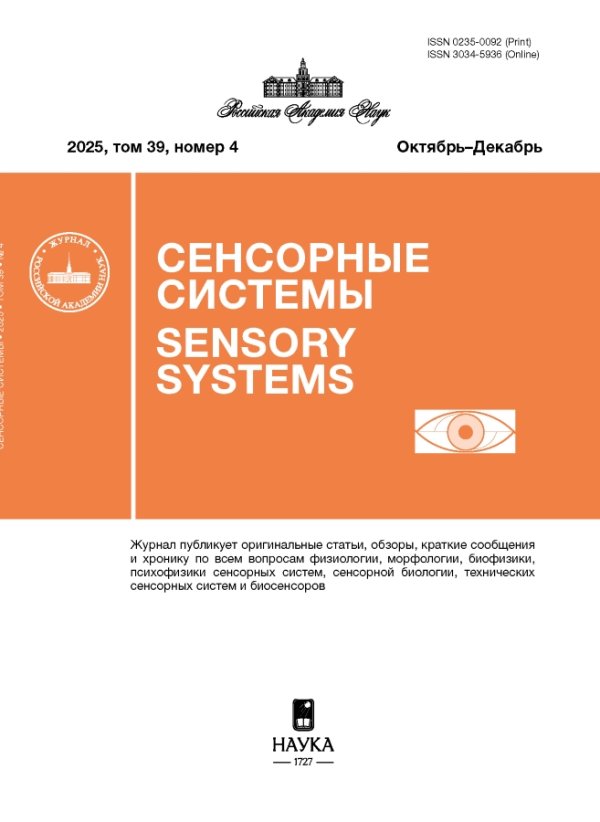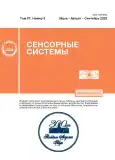Поведенческие реакции тараканов Periplaneta americana L. на коротко- и длинноволновый свет в ветровом тоннеле
- Авторы: Жуковская М.И.1, Щеникова А.В.2, Селицкая О.Г.2, Мильцын А.А.2, Новикова Е.С.1, Фролов А.Н.2
-
Учреждения:
- Институт эволюционной физиологии и биохимии им. И.М. Сеченова РАН
- Всероссийский научно-исследовательский институт защиты растений РАН
- Выпуск: Том 37, № 3 (2023)
- Страницы: 235-243
- Раздел: ЗРИТЕЛЬНАЯ СИСТЕМА
- URL: https://journals.rcsi.science/0235-0092/article/view/138232
- DOI: https://doi.org/10.31857/S0235009223030083
- EDN: https://elibrary.ru/UGWKWM
- ID: 138232
Цитировать
Полный текст
Аннотация
В условиях ветрового тоннеля изучали поведенческие реакции американского таракана Periplaneta americana на излучение ультрафиолетового и зеленого светодиодов. Направленное к источнику света движение насекомых отмечалось в ответ на оба стимула, однако латентный период ответа на зеленый свет оказался существенно короче. Первоначально двигавшиеся к источнику ультрафиолета тараканы часто возвращались обратно в менее освещенное место старта, тогда как в условиях освещения зеленым светом такое поведение было нехарактерно. При ультрафиолетовом освещении тараканы нередко замирали, демонстрируя реакцию маскинга, характерную для неактивной, дневной фазы суточного цикла.
Ключевые слова
Об авторах
М. И. Жуковская
Институт эволюционной физиологии и биохимии им. И.М. Сеченова РАН
Автор, ответственный за переписку.
Email: mzhukovskaya@yahoo.com
Россия, 194223, С.-Петербург, пр. Тореза, 44
А. В. Щеникова
Всероссийский научно-исследовательский институт защиты растений РАН
Email: mzhukovskaya@yahoo.com
Россия,
196608, Санкт-Петербург, г. Пушкин, ш. Подбельского, д. 3
О. Г. Селицкая
Всероссийский научно-исследовательский институт защиты растений РАН
Email: mzhukovskaya@yahoo.com
Россия,
196608, Санкт-Петербург, г. Пушкин, ш. Подбельского, д. 3
А. А. Мильцын
Всероссийский научно-исследовательский институт защиты растений РАН
Email: mzhukovskaya@yahoo.com
Россия,
196608, Санкт-Петербург, г. Пушкин, ш. Подбельского, д. 3
Е. С. Новикова
Институт эволюционной физиологии и биохимии им. И.М. Сеченова РАН
Email: mzhukovskaya@yahoo.com
Россия, 194223, С.-Петербург, пр. Тореза, 44
А. Н. Фролов
Всероссийский научно-исследовательский институт защиты растений РАН
Email: mzhukovskaya@yahoo.com
Россия,
196608, Санкт-Петербург, г. Пушкин, ш. Подбельского, д. 3
Список литературы
- Горностаев Г.Н. Введение в этологию насекомых – фотоксенов (лет насекомых на искусственные источники света). Тр. Всесоюзного Энтомол. Общества. Т. 66 “Этология насекомых”. Л.: Наука, 1984. Т. 66. С. 101–167.
- Грибакин Ф.Г. Механизмы фоторецепции насекомых. Ленингр. отд-ние. Наука, 1981. 213 с.
- Дремова В.П., Алешко Н.А. Тараканы. Биология, экология, санитарно-эпидемиологическое значение, контроль численности синантропных тараканов. М.: Товарищество научных изданий КМК, 2011. 305 с.
- Жуковская М.И. Поведенческое доказательство существования агрегационного феромона американского таракана Periplaneta americana (L.). Журн. эвол. биохим. физиол. 1991. Т. 27. № 5. С. 661–666.
- Жуковская М.И., Новикова Е.С., Северина И.Ю., Исавнина И.Л. Даунрегуляция зрительных пигментов таракана с помощью метода РНК-интерференции. Журн. эвол. биохим. физиол. 2020. Т. 56. № 7. С. 587–597. https://doi.org/10.31857/S0044452920071353
- Жуковская М.И., Северина И.Ю., Новикова Е.С. Световое антропогенное загрязнение: действие на насекомых. Биосфера. 2022. Т. 14. № 2. С. 126–136. https://doi.org/10.24855/biosfera.v14i2.669
- Мазохин-Поршняков Г.А. Зрение насекомых. М.: Наука, 1965. 264 с.
- Новикова Е.С., Северина И.Ю., Исавнина И.Л., Жуковская М.И. Даунрегуляция ультрафиолет-чувствительного зрительного пигмента таракана уменьшает эффект маскинга при коротковолновом освещении. Сенсорные системы. 2021. Т. 35. № 1. С. 22–29. https://doi.org/10.31857/S0235009221010066
- Новикова Е.С., Жуковская М.И. Реакция замирания под действием яркого света у американского таракана, Periplaneta americana. Сенсорные системы. 2017. Т. 31. № 1. С. 44–50.
- Щеникова А.В., Селицкая О.Г. Система лабораторного тестирования поведенческих реакций кукурузного мотылька. Научное обеспечение развития АПК в условиях импортозамещения. Сборник научных трудов по материалам международной научно-практической конференции “Развитие агропромышленного комплекса на основе современных научных достижений и цифровых технологий”. Санкт-Петербург – Пушкин. 2019. Ч. 1. С. 108–112.
- Abbas M., Ramzan M., Hussain N., Ghaffar A., Hussain K., Abbas S., Raza A. Role of light traps in attracting, killing and biodiversity studies of insect pests in Thal. Pakistan Journal of Agricultural Research. 2019. V. 32 (4). P. 684–690. https://doi.org/10.17582/journal.pjar/2019/32.4.684.690
- Avarguès-Weber A., Mota T., Giurfa M. New vistas on honey bee vision. Apidologie. 2012. V. 43. P. 244–268. https://doi.org/10.1007/s13592-012-0124-2
- Baker T.C., Linn C.E. Wind tunnels in pheromone research. In: H. E. Hummel, T.A. Miller (eds.). Techniques in Pheromone Research. New York, Springer. 1984. P. 75–110. https://doi.org/10.1007/978-1-4612-5220-7_3
- Briscoe A.D., Chittka L. The evolution of color vision in insects. Annu. Rev. Entomol. 2001. V. 46. P. 471–510. https://doi.org/10.1146/annurev.ento.46.1.471
- Buschbeck E.K., Friedrich M. Evolution of insect eyes: tales of ancient heritage, deconstruction, reconstruction, remodeling, and recycling. Evolution: Education and Outreach. 2008. V. 1. P. 448–462. https://doi.org/10.1007/s12052-008-0086-z
- Collett M., Chittka L., and Collett T.S. Spatial memory in insect navigation. Curr. Biol. 2013. V. 23 (17). P. R789–R800. https://doi.org/10.1016/j.cub.2013.07.020
- Deng J.Y., Wei H.Y., Huang Y.P., Du J.W. Enhancement of attraction to sex pheromones of Spodoptera exigua by volatile compounds produced by host plants. J. Chem. Ecol. 2004. V. 30 (10). P. 2037–2045. https://doi.org/10.1023/B:JOEC.0000045593.62422.73
- Evangelista D.A., Russell G., Russell K.N., Bourne G., Ware J.L. Evidence that dispersal barriers influence blaberoid cockroach assemblages in a neotropical savanna–forest matrix. Insect. Conserv. Divers. 2017. V. 10 (5). P. 425–438. https://doi.org/10.1111/icad.12246
- Frolov A., Shchenikova A., Selitskaya O., Grushevaya I., Zhukovskaya M., Fedoseev N., Kuzmin A., Lastushkina E., Kurenshchikov D., Kurenshchikov V., Tóth M. Asian corn borer (Ostrinia furnacalis Gn., Lepidoptera: Crambidae): attraction to a bisexual lure and comparison of performance with synthetic sex pheromone. Acta Phytopathol. Entomol. Hung. 2022. V. 57 (2). P. 148–164. https://doi.org/10.1556/038.2022.00159
- Goldsmith T.H., Ruck P.R. The spectral sensitivities of the dorsal ocelli of cockroaches and honeybees: an electrophysiological study. J. Gen. Physiol. 1958. V. 41 (6). P. 1171. https://doi.org/10.1085/jgp.41.6.1171
- Greiner B. Adaptations for nocturnal vision in insect apposition eyes. International Review of Cytology. 2006. V. 250. P. 1–46. https://doi.org/10.1016/S0074-7696(06)50001-4
- Hatano E., Wada-Katsumata A., Schal C. Environmental decomposition of olefinic cuticular hydrocarbons of Periplaneta americana generates a volatile pheromone that guides social behaviour. Proc. Royal Soc. B. 2020. V. 287 (1921). P. 20192466. https://doi.org/10.1098/rspb.2019.2466.
- Heimonen K., Salmela I., Kontiokari P., Weckström M. Large functional variability in cockroach photoreceptors: optimization to low light levels. J Neurosci. 2006. V. 26. P. 13454–13462. https://doi.org/10.1523/JNEUROSCI.3767-06.2006
- Helfrich-Förster C. Light input pathways to the circadian clock of insects with an emphasis on the fruit fly Drosophila melanogaster. J. Comp. Physiol. A. 2020. V. 206 (2). P. 259–272. https://doi.org/10.1007/s00359-019-01379-5
- Hinze A., Lantz J., Hill S.R., Ignell R. Mosquito host seeking in 3D using a versatile climate-controlled wind tunnel system. Front. Behav. Neurosci. 2021. V. 15. P. 643693. https://doi.org/10.3389/fnbeh.2021.643693
- Kainoh Y. Wind tunnel: a tool to test the flight response to semiochemicals. In: J.C. Lerner, U. Boldes (eds.). Wind Tunnels and Experimental Fluid Dynamics Research. 2011. P. 89–99.
- Kalueff A.V., Stewart A.M., Song C., Berridge K.C., Graybiel A.M., Fentress J.C. Neurobiology of rodent self-grooming and its value for translational neuroscience. Nat. Rev. Neurosci. 2016. V. 17. P. 45–59. https://doi.org/10.1038/nrn.2015.8
- Kelber A., Osorio D. From spectral information to animal colour vision: experiments and concepts. Proc. Royal Soc. B. 2010. V. 277 (1688). P. 1617–1625. https://doi.org/10.1098/rspb.2009.2118
- Kelly K.M., Mote M.I. Electrophysiology and anatomy of medulla interneurons in the optic lobe of the cockroach, Periplaneta americana. J. Comp. Physiol. A. 1990a. V. 167. P. 745–756. https://doi.org/10.1007/bf00189765
- Kelly K.M., Mote M.I. Avoidance of monochromatic light by the cockroach Periplaneta americana. J. Insect Physiol. 1990b. V. 36 (4). P. 287–291. https://doi.org/10.1016/0022-1910(90)90113-T
- Knudsen G.K., Tasin M., Aak A., Thöming G. A wind tunnel for odor mediated insect behavioural assays. J. Vis. Exp. 2018. V. 30 (141). P. e58385. https://doi.org/10.3791/58385
- Ludwig W. Seitenstetigkeit niederer Tiere im Ein- und Zweilichtversuche. I. Limantria dispar-Raupen. Zeitschrift für wissenschaftliche Zoologie. 1933, Bd 144 (4). S. 469–495.
- Menzel R. Spectral sensitivity and color vision in invertebrates. Comparative physiology and evolution of vision in invertebrates. Berlin, Heidelberg, Springer, 1979. P. 503–580.
- Menzi U. Visual adaptation in nocturnal and diurnal ants. J. Comp. Physiol. A. 1987. V. 160. P. 11–21. https://doi.org/10.1007/BF00613437
- Miller J.R., Roelofs W.L. Sustained-flight tunnel for measuring insect responses to wind-borne sex pheromones. J. Chem. Ecol. 1978. V. 4 (2). P. 187–198. https://doi.org/10.1007/BF00988054
- Mizunami M. Neural organization of ocellar pathways in the cockroach brain. Journal of Comparative Neurology. 1995. V. 352 (3). P. 458–468. https://doi.org/10.1002/cne.903520310
- Mote M.I., Goldsmith T.H. Spectral sensitivities of color receptors in the compound eye of the cockroach Periplaneta. Journal of Experimental Zoology. 1970. V. 173 (2). P. 137–145. https://doi.org/10.1002/jez.1401730203
- Mrosovsky N. Masking: history, definitions, and measurement. Chronobiol. Int. 1999. V. 16 (4). P. 415–429. https://doi.org/10.3109/07420529908998717
- Nowinszky L. The orientation of insects by light–major theories. In: L. Nowinszky (ed.). The handbook of light trapping. Szombathely, Savaria University Press. 2003. P. 15–18.
- Okada J., Toh Y. Shade response in the escape behavior of the cockroach, Periplaneta americana. Zool. Sci. 1998. V. 15 (6). P. 831–835. https://doi.org/10.2108/zsj.15.831
- Page T.L. Transplantation of the cockroach circadian pacemaker. Science. 1982. V. 216 (4541). P. 73–75. https://doi.org/10.1126/science.216.4541.73
- Page T.L., Koelling E. Circadian rhythm in olfactory response in the antennae controlled by the optic lobe in the cockroach. J. Insect Physiol. 2003. V. 49 (7). P. 697–707. https://doi.org/10.1016/S0022-1910(03)00071-4
- Roelofs W.L., Cardé R.T. Responses of Lepidoptera to synthetic sex pheromone chemicals and their analogues. Annu. Rev. Entomol. 1977. V. 22 (1). P. 377–405. https://doi.org/10.1146/annurev.en.22.010177.002113
- Song B.M., Lee C.H. Toward a mechanistic understanding of color vision in insects. Fron. Neural Circuits. 2018. V. 12. P. 16. https://doi.org/10.3389/fncir.2018.00016
- Subhash S., Shashank P.R. Wind Tunnel: A tool to test the flight response of insects to semiochemicals. In: A. Kumar Chakravarthy, V. Selvanarayanan (eds.). Experimental Techniques in Host-Plant Resistance. Singapore, Springer. 2019. P. 65–69.
- Tinbergen N. The study of instinct. Oxford, Clarendon Press. 1951.
- Van Der Kooi C.J., Stavenga D.G., Arikawa K., Belušič G., Kelber A. Evolution of insect color vision: from spectral sensitivity to visual ecology. Annu. Rev. Entomol. 2021. V. 66. P. 435–461. https://doi.org/10.1146/annurev-ento-061720-071644
- Warrant E.J. Vision in the dimmest habitats on earth. J. Comp. Physiol. A. 2004. V. 190. P. 765–789. https://doi.org/10.1007/s00359-004-0546-z
- Warrant E. Nocturnal Vision. In: R. H. Masland, T. Albright (eds.). The senses. San Diego, Elsevier. 2008. P. 54–82.
- Warrant E.J., Kelber A., Gisleґn A., Greiner B., Ribi W., Wcislo W.T. Nocturnal vision and landmark orientation in a tropical halictid bee. Curr. Biol. 2004. V. 14. P. 1309–1318. https://doi.org/10.1016/j.cub.2004.07.057
- Warrant E., Somanathan H. Colour vision in nocturnal insects. Philos. Trans. R. Soc. Lond., B, Biol. Sci. 2022. V. 377 (1862). P. 20210285. https://doi.org/10.1098/rstb.2021.0285
- Wolda H. Diversity, diversity indices and tropical cockroaches. Oecologia. 1983. 58. P. 290–298. https://doi.org/10.1007/BF00385226
- Zhukovskaya M., Yanagawa A., Forschler B. Grooming behavior as a mechanism of insect disease defense. Insects. 2013. V. 4 (4). P. 609–630. https://doi.org/10.3390/insects4040609
- Zhukovskaya M., Novikova E., Saari P., Frolov R.V. Behavioral responses to visual overstimulation in the cockroach Periplaneta americana L. J. Comp. Physiol. A. 2017. V. 203 (12). P. 1007–1015. https://doi.org/10.1007/s00359-017-1210-8













